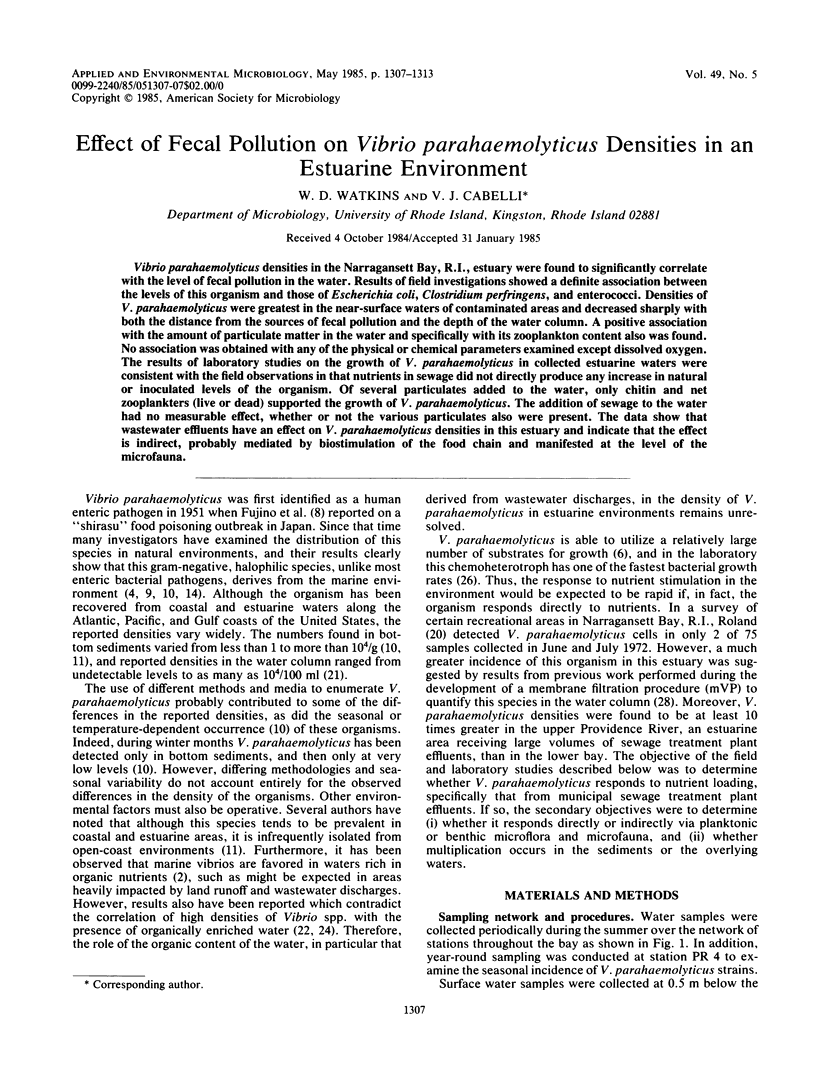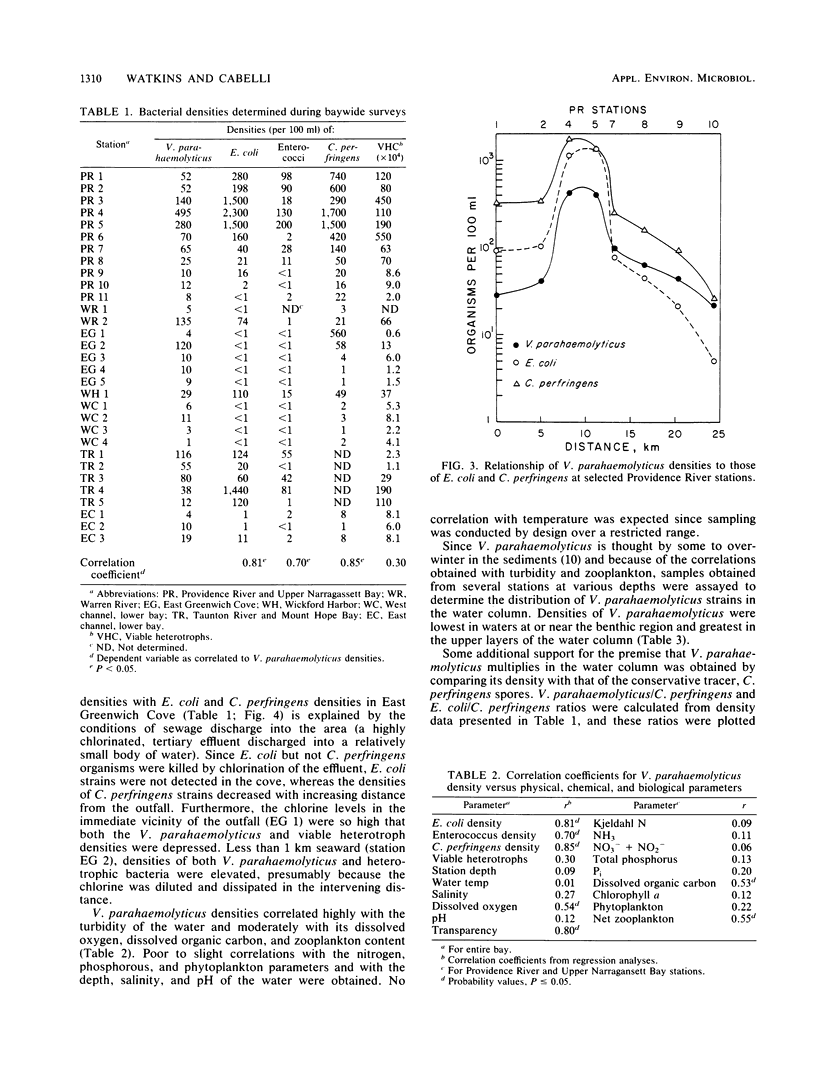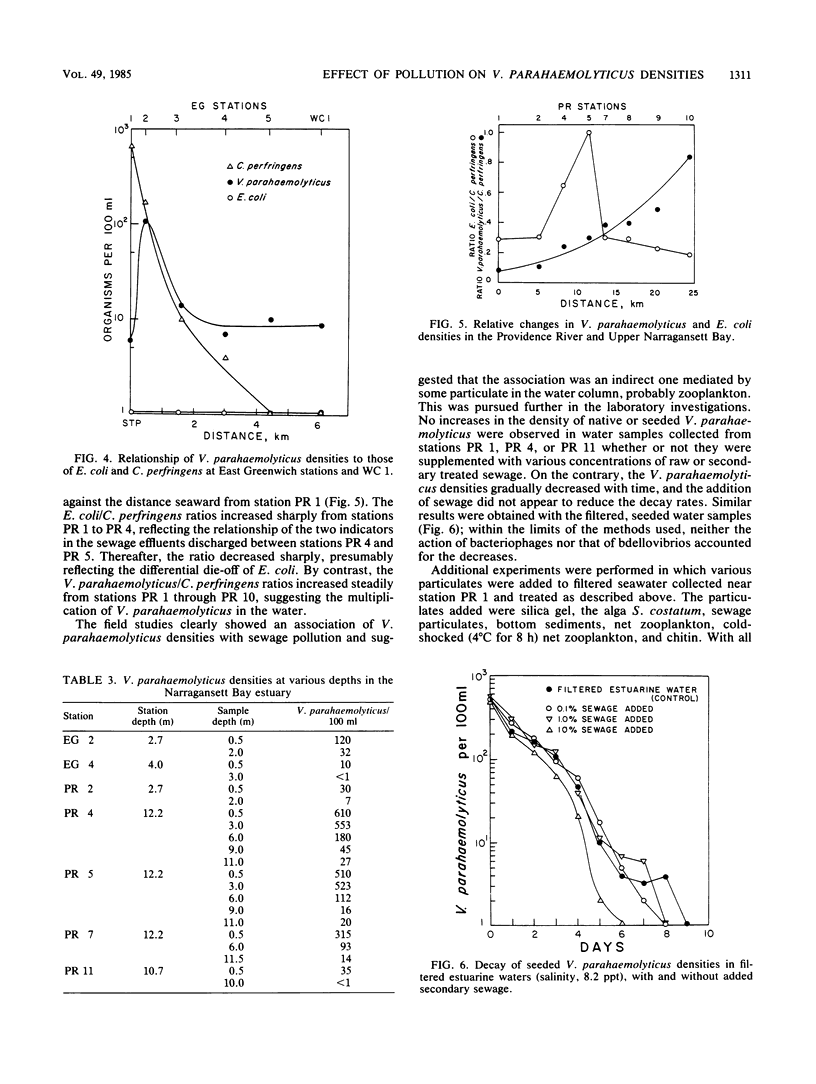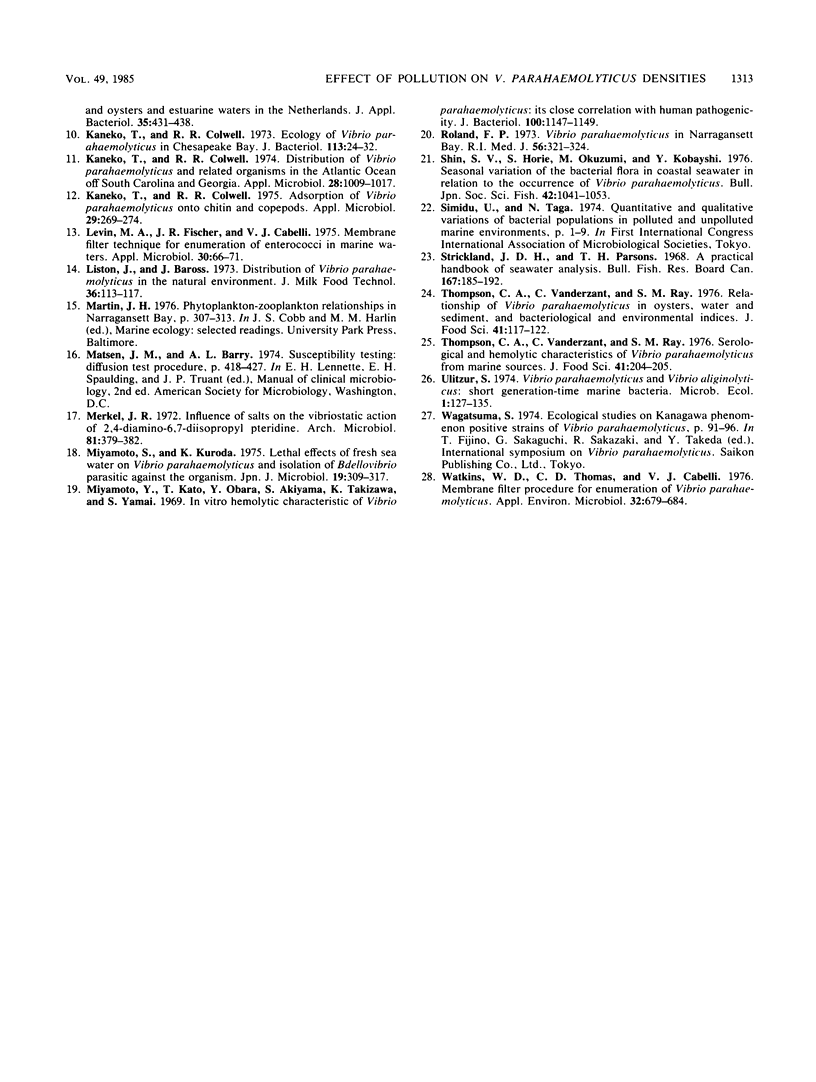Abstract
Vibrio parahaemolyticus densities in the Narragansett Bay, R.I., estuary were found to significantly correlate with the level of fecal pollution in the water. Results of field investigations showed a definite association between the levels of this organism and those of Escherichia coli, Clostridium perfringens, and enterococci. Densities of V. parahaemolyticus were greatest in the near-surface waters of contaminated areas and decreased sharply with both the distance from the sources of fecal pollution and the depth of the water column. A positive association with the amount of particulate matter in the water and specifically with its zooplankton content also was found. No association was obtained with any of the physical or chemical parameters examined except dissolved oxygen. The results of laboratory studies on the growth of V. parahaemolyticus in collected estuarine waters were consistent with the field observations in that nutrients in sewage did not directly produce any increase in natural or inoculated levels of the organism. Of several particulates added to the water, only chitin and net zooplankters (live or dead) supported the growth of V. parahaemolyticus. The addition of sewage to the water had no measurable effect, whether or not the various particulates also were present. The data show that wastewater effluents have an effect on V. parahaemolyticus densities in this estuary and indicate that the effect is indirect, probably mediated by biostimulation of the food chain and manifested at the level of the microfauna.
Full text
PDF






Selected References
These references are in PubMed. This may not be the complete list of references from this article.
- Baross J. A., Liston J., Morita R. Y. Incidence of Vibrio parahaemolyticus bacteriophages and other Vibrio bacteriophages in marine samples. Appl Environ Microbiol. 1978 Sep;36(3):492–499. doi: 10.1128/aem.36.3.492-499.1978. [DOI] [PMC free article] [PubMed] [Google Scholar]
- Baross J., Liston J. Occurrence of Vibrio parahaemolyticus and related hemolytic vibrios in marine environments of Washington State. Appl Microbiol. 1970 Aug;20(2):179–186. doi: 10.1128/am.20.2.179-186.1970. [DOI] [PMC free article] [PubMed] [Google Scholar]
- Bartley C. H., Slanetz L. W. Occurrence of Vibrio parahaemolyticus in estuarine waters and oysters of New Hampshire. Appl Microbiol. 1971 May;21(5):965–966. doi: 10.1128/am.21.5.965-966.1971. [DOI] [PMC free article] [PubMed] [Google Scholar]
- Bisson J. W., Cabelli V. J. Membrane filter enumeration method for Clostridium perfringens. Appl Environ Microbiol. 1979 Jan;37(1):55–66. doi: 10.1128/aem.37.1.55-66.1979. [DOI] [PMC free article] [PubMed] [Google Scholar]
- DAVIS G. H., PARK R. W. A taxonomic study of certain bacteria currently classified as Vibrio species. J Gen Microbiol. 1962 Jan;27:101–119. doi: 10.1099/00221287-27-1-101. [DOI] [PubMed] [Google Scholar]
- Dufour A. P., Strickland E. R., Cabelli V. J. Membrane filter method for enumerating Escherichia coli. Appl Environ Microbiol. 1981 May;41(5):1152–1158. doi: 10.1128/aem.41.5.1152-1158.1981. [DOI] [PMC free article] [PubMed] [Google Scholar]
- Kaneko T., Colwell R. R. Adsorption of Vibrio parahaemolyticus onto chitin and copepods. Appl Microbiol. 1975 Feb;29(2):269–274. doi: 10.1128/am.29.2.269-274.1975. [DOI] [PMC free article] [PubMed] [Google Scholar]
- Kaneko T., Colwell R. R. Distribution of Vibrio parahaemolyticus and related organisms in the Atlantic Ocean off South Carolina and Georgia. Appl Microbiol. 1974 Dec;28(6):1009–1017. doi: 10.1128/am.28.6.1009-1017.1974. [DOI] [PMC free article] [PubMed] [Google Scholar]
- Kaneko T., Colwell R. R. Ecology of Vibrio parahaemolyticus in Chesapeake Bay. J Bacteriol. 1973 Jan;113(1):24–32. doi: 10.1128/jb.113.1.24-32.1973. [DOI] [PMC free article] [PubMed] [Google Scholar]
- Levin M. A., Fischer J. R., Cabelli V. J. Membrane filter technique for enumeration of enterococci in marine waters. Appl Microbiol. 1975 Jul;30(1):66–71. doi: 10.1128/am.30.1.66-71.1975. [DOI] [PMC free article] [PubMed] [Google Scholar]
- Merkel J. R. Influence of salts on the vibriostatic action of 2,4-diamino-6,7-diisopropyl pteridine. Arch Mikrobiol. 1972;81(4):379–382. doi: 10.1007/BF00412644. [DOI] [PubMed] [Google Scholar]
- Miyamoto S., Kuroda K. Lethal effect of fresh sea water on Vibrio parahaemolyticus and isolation of Bdellovibrio parasitic against the organism. Jpn J Microbiol. 1975 Aug;19(4):309–317. doi: 10.1111/j.1348-0421.1975.tb00884.x. [DOI] [PubMed] [Google Scholar]
- Miyamoto Y., Kato T., Obara Y., Akiyama S., Takizawa K., Yamai S. In vitro hemolytic characteristic of Vibrio parahaemolyticus: its close correlation with human pathogenicity. J Bacteriol. 1969 Nov;100(2):1147–1149. doi: 10.1128/jb.100.2.1147-1149.1969. [DOI] [PMC free article] [PubMed] [Google Scholar]
- Roland F. P. Vibrio parahemolyticus in Narragansett Bay. R I Med J. 1973 Aug;56(8):321–324. [PubMed] [Google Scholar]
- Watkins W. D., Thomas C. D., Cabelli V. J. Membrane filter procedure for enumeration of Vibrio parahaemolyticus. Appl Environ Microbiol. 1976 Nov;32(5):679–684. doi: 10.1128/aem.32.5.679-684.1976. [DOI] [PMC free article] [PubMed] [Google Scholar]


